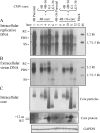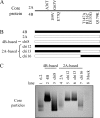Characterization of the pleiotropic effects of the genotype G-specific 36-nucleotide insertion in the context of other hepatitis B virus genotypes
- PMID: 21994450
- PMCID: PMC3233120
- DOI: 10.1128/JVI.05583-11
Characterization of the pleiotropic effects of the genotype G-specific 36-nucleotide insertion in the context of other hepatitis B virus genotypes
Abstract
The pregenomic RNA (pgRNA) of hepatitis B virus (HBV) serves as the messenger for both core and P proteins, with the downstream P gene translated by ribosomal leaky scanning. HBV replication begins with packaging of the pgRNA and P protein into core protein particles, followed by conversion of RNA into DNA. Genotype G has a low replication capacity due to a low pgRNA level. It has a 36-nucleotide (nt) insertion in the 5' end of the core gene, adding 12 residues to the core protein. The insertion is needed to maintain efficient core protein expression and genome replication but causes inefficient virion secretion yet high maturity of virion DNA. In the present study, we confirmed that the 36-nt insertion had similar effects on core protein expression and virion secretion when it was introduced into genotype A and D clones but no impact on virion genome maturity. Surprisingly, the insertion impaired genome replication in both genotypes. Transcomplementation assays suggest that increased efficiency of core protein translation diminishes ribosomal scanning toward the downstream P gene. Indeed, mutating the core gene Kozak sequence restored core protein to lower levels but increased replication of the insertion mutant. Similar mutations impaired replication in genotype G. On the other hand, replacement of the core promoter sequence of genotype G with genotype A sequence increased pgRNA transcription and genome replication, implicating this region in the low replication capacity of genotype G. Why the 36-nt insertion is present in genotype G but absent in other genotypes is discussed.
Figures









Similar articles
-
Critical role of the 36-nucleotide insertion in hepatitis B virus genotype G in core protein expression, genome replication, and virion secretion.J Virol. 2007 Sep;81(17):9202-15. doi: 10.1128/JVI.00390-07. Epub 2007 Jun 13. J Virol. 2007. PMID: 17567705 Free PMC article.
-
Hepatitis B virus genotype C isolates with wild-type core promoter sequence replicate less efficiently than genotype B isolates but possess higher virion secretion capacity.J Virol. 2011 Oct;85(19):10167-77. doi: 10.1128/JVI.00819-11. Epub 2011 Jul 20. J Virol. 2011. PMID: 21775451 Free PMC article.
-
High serum levels of pregenomic RNA reflect frequently failing reverse transcription in hepatitis B virus particles.Virol J. 2018 May 15;15(1):86. doi: 10.1186/s12985-018-0994-7. Virol J. 2018. PMID: 29764511 Free PMC article.
-
Intracellular Trafficking of HBV Particles.Cells. 2020 Sep 2;9(9):2023. doi: 10.3390/cells9092023. Cells. 2020. PMID: 32887393 Free PMC article. Review.
-
Mechanism of HBV genome variability and replication of HBV mutants.J Clin Virol. 2005 Dec;34 Suppl 1:S134-8. doi: 10.1016/s1386-6532(05)80023-x. J Clin Virol. 2005. PMID: 16461214 Review.
Cited by
-
Immunoinformatics and Evaluation of Peptide Vaccines Derived from Global Hepatitis B Viral HBx and HBc Proteins Critical for Covalently Closed Circular DNA Integrity.Microorganisms. 2023 Nov 21;11(12):2826. doi: 10.3390/microorganisms11122826. Microorganisms. 2023. PMID: 38137971 Free PMC article.
-
High prevalence of hepatitis B virus dual infection with genotypes A and G in HIV-1 infected men in Amsterdam, the Netherlands, during 2000-2011.BMC Infect Dis. 2013 Nov 14;13:540. doi: 10.1186/1471-2334-13-540. BMC Infect Dis. 2013. PMID: 24225261 Free PMC article.
-
Differential regulation of hepatitis B virus core protein expression and genome replication by a small upstream open reading frame and naturally occurring mutations in the precore region.Virology. 2017 May;505:155-161. doi: 10.1016/j.virol.2017.02.020. Epub 2017 Mar 3. Virology. 2017. PMID: 28260621 Free PMC article.
-
Core gene insertion in hepatitis B virus genotype G functions at both the encoded amino acid sequence and RNA structure levels to stimulate core protein expression.Virology. 2019 Jan 2;526:203-213. doi: 10.1016/j.virol.2018.11.002. Epub 2018 Nov 8. Virology. 2019. PMID: 30415131 Free PMC article.
-
RNA binding protein TIAR modulates HBV replication by tipping the balance of pgRNA translation.Signal Transduct Target Ther. 2023 Sep 13;8(1):346. doi: 10.1038/s41392-023-01573-7. Signal Transduct Target Ther. 2023. PMID: 37699883 Free PMC article.
References
-
- Bang G., et al. 2005. Effect of mutating the two cysteines required for HBe antigenicity on hepatitis B virus DNA replication and virion secretion. Virology 332:216–224 - PubMed
-
- Bhat R. A., Ulrich P. P., Vyas G. N. 1990. Molecular characterization of a new variant of hepatitis B virus in a persistently infected homosexual man. Hepatology 11:271–276 - PubMed
Publication types
MeSH terms
Substances
Grants and funding
LinkOut - more resources
Full Text Sources
Research Materials

